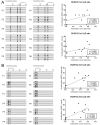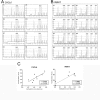Genome-wide DNA methylation profiles according to Chlamydophila psittaci infection and the response to doxycycline treatment in ocular adnexal lymphoma
- PMID: 25053874
- PMCID: PMC4105114
Genome-wide DNA methylation profiles according to Chlamydophila psittaci infection and the response to doxycycline treatment in ocular adnexal lymphoma
Abstract
Purpose: To compare genome-wide DNA methylation profiles according to Chlamydophila psittaci (Cp) infection status and the response to doxycycline treatment in Korean patients with ocular adnexal extranodal marginal zone B-cell lymphoma (EMZL).
Methods: Twelve ocular adnexal EMZL cases were classified into two groups (six Cp-positive cases and six Cp-negative cases). Among the 12 cases, eight were treated with doxycycline as first-line therapy, and they were divided into two groups according to their response to the treatment (four doxy-responders and four doxy-nonresponders). The differences in the DNA methylation states of 27,578 methylation sites in 14,000 genes were evaluated using Illumina bead assay technology. We also validated the top-ranking differentially methylated genes (DMGs) with bisulfite direct sequencing or pyrosequencing.
Results: The Infinium methylation chip assay revealed 180 DMGs in the Cp-positive group (74 hypermethylated genes and 106 hypomethylated genes) compared to the Cp-negative group. Among the 180 DMGs, DUSP22, which had two significantly hypomethylated loci, was validated, and the correlation was significant for one CpG site (Spearman coefficient=0.6478, p=0.0262). Regarding the response to doxycycline treatment, a total of 778 DMGs were revealed (389 hypermethylated genes and 336 hypomethylated genes in the doxy-responder group). In a subsequent replication study for representative hypomethylated (IRAK1) and hypermethylated (CXCL6) genes, the correlation between the bead chip analysis and pyrosequencing was significant (Spearman coefficient=0.8961 and 0.7619, respectively, p<0.05).
Conclusions: Ocular adnexal EMZL showed distinct methylation patterns according to Cp infection and the response to doxycycline treatment in this genome-wide methylation study. Among the candidate genes, DUSP22 has a methylation status that was likely attributable to Cp infection. Our data also suggest that the methylation statuses of IRAK1 and CXCL6 may reflect the response to doxycycline treatment.
Figures





References
-
- Coupland SE, Krause L, Delecluse HJ, Anagnostopoulos I, Foss HD, Hummel M, Bornfeld N, Lee WR, Stein H. Lymphoproliferative lesions of the ocular adnexa. Analysis of 112 cases. Ophthalmology. 1998;105:1430–41. - PubMed
-
- Moslehi R, Devesa SS, Schairer C, Fraumeni JF., Jr Rapidly increasing incidence of ocular non-hodgkin lymphoma. J Natl Cancer Inst. 2006;98:936–9. - PubMed
-
- Ferreri AJ, Dolcetti R, Du MQ, Doglioni C, Resti AG, Politi LS, De Conciliis C, Radford J, Bertoni F, Zucca E, Cavalli F, Ponzoni M. Ocular adnexal MALT lymphoma: an intriguing model for antigen-driven lymphomagenesis and microbial-targeted therapy. Ann Oncol. 2008;19:835–46. - PubMed
-
- Oh DE, Kim YD. Lymphoproliferative diseases of the ocular adnexa in Korea. Arch Ophthalmol. 2007;125:1668–73. - PubMed
Publication types
MeSH terms
Substances
LinkOut - more resources
Full Text Sources
Medical
Miscellaneous

